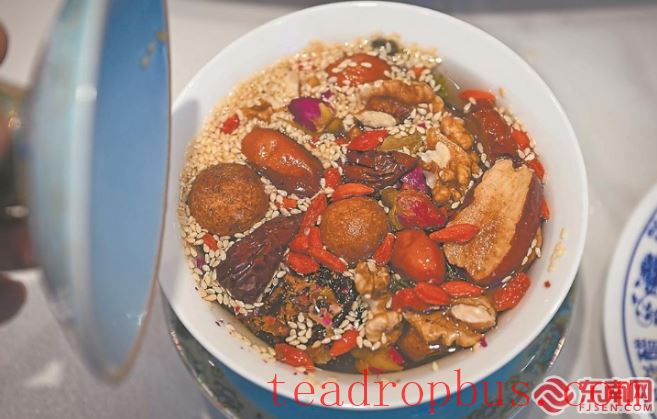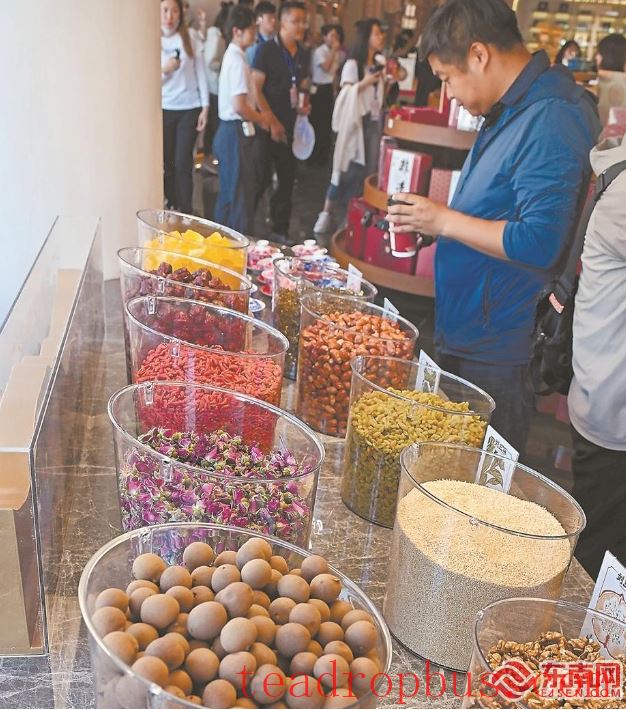“In this bowl of Eight-Treasure Tea, the wolfberries and desert jujubes come from Ningxia, the longans from Putian in Fujian, the raisins and walnuts from Xinjiang, the sesame seeds from Henan, the raw Pu'er tea from Yunnan, and the rose petals from Shandong…” On the morning of the 12th, the thematic promotional group “Solidifying a Community of Common Destiny: The Chinese Family United” visited the Liu Sanduo Eight-Treasure Tea Intangible Cultural Heritage Experience Hall in Wuzhong, Ningxia. Yang Wei, inheritor of the Eight-Treasure Tea intangible cultural heritage and general manager of Ningxia Liu Sanduo Eight-Treasure Tea Technology Co., Ltd., introduced the ingredients of Wuzhong's Eight-Treasure Tea to reporters from all over the country.

Wuzhong Eight-Treasure Tea
“Wuzhong has historically been a commercial hub on the ancient Silk Road, known as a ‘water and land wharf, a great market of the world.' Leveraging its advantageous geographic location by the Yellow River, merchants from both the south and north have flocked here continuously, promoting local economic prosperity and fostering a collision, influence, and mutual learning between different culinary cultures, gradually shaping the unique dining customs of Wuzhong.” According to a Wuzhong breakfast culture guide, “Represented by the Eight-Treasure Tea, Wuzhong's breakfast tea epitomizes the vivid practice of ethnic exchange, interaction, and integration among the people of Wuzhong and solidifies the sense of community within the Chinese nation. One could say that the fusion of various ethnic groups is also concentrated in this bowl of sweet, fragrant, and rich covered-bowl tea.”
Influenced by geographical environment and dietary habits, people in Wuzhong favor beef and mutton, both of which are relatively greasy. Hot tea helps to clear away the oiliness, and after eating these meats, drinking a cup of hot tea eliminates the uncomfortable feeling of greasy lips and mouth. According to historical records, the custom of Drinking Tea in Wuzhong dates back to the Qin and Han dynasties.

Liu Sanduo Eight-Treasure Tea Intangible Cultural Heritage Experience Hall
“During the Qin and Han dynasties, this was a transportation hub and an ethnic bond in the northern border region. In the Northern Wei period, nearly 30,000 people from the south migrated here, bringing with them the cultivation of tea and the custom of drinking tea,” explained the guide. By the Tang Dynasty, Wuzhong had become an important channel on the ancient Silk Road, and tea-horse trade and exchanges of goods between the East and West flourished, leading to continuous changes and enrichments in tea-drinking methods and contents. “In the poem ‘Fragrant beneath the green cliffs of Lingzhou,' the Tang dynasty poet Wu Yuanheng depicted the scene of locals drinking morning tea at that time. Since then, as various ethnic groups and populations continued to migrate to Wuzhong, different cuisines were constantly integrated, and the Wuzhong breakfast tea evolved from simple tea leaves to include three, five, ten, and eventually settling on eight flavors after a long period of sedimentation.”
“A beautiful day for the people of Wuzhong begins with a steaming bowl of Eight-Treasure Tea.” Ma Lihong, director of the Wuzhong Municipal Bureau of Culture, Tourism, Sports, and Radio & TV, told reporters that Wuzhong's culinary preparation methods fully absorb the distinctive techniques of cuisines such as Beijing and Shandong styles. Wuzhong's breakfast tea reflects the diverse integration of Yellow River culture, red culture, ethnic culture, nomadic culture, and farming culture. “With Wuzhong's breakfast tea as the lead, we have held four Wuzhong Breakfast Food Festivals, launching premium tourism routes that integrate dining, accommodation, travel, shopping, and entertainment, and building the brand ‘Travel in Ningxia, Dine in Wuzhong,' achieving mutual benefits between commerce, tourism, and culture. Brands such as Xiangdingding, Du Youzu, Liu Sanduo, Yanchi Cashmere Goat, Xinhai, and Xixianji have rapidly emerged, providing a solid guarantee for the high-quality ingredients used in Wuzhong's breakfast tea.”
Statistics show that in 2025, there are over 780 breakfast tea restaurants in Wuzhong, generating sales revenue of 1.5 billion yuan; the city has cumulatively received 13.73 million tourists, generating tourism income of 8 billion yuan. (Guo Bin)